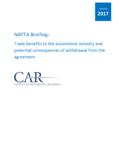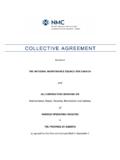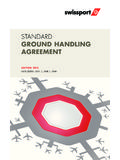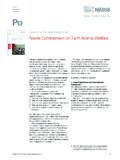Transcription of TUNA A global perspective
1 Food and Agriculture Organizationof the United Nations (FAO)FAO FISHERIES AND AQUACULTURE DEPARTMENTTUNAA global perspectiveTuna and tuna-like species are a significant source of nutritious food and livelihoods. They are very important economically to both developed and developing countries. They include approximately 40 species occurring in the Atlantic, Indian and Pacific Oceans and in the Mediterranean Sea. Their annual global production has tended to increase continuously, from less than million tonnes in 1950 to almost million tonnes in 2010. In that year, the catch of the most important economically species (so-called principal market species) was million value at-landing of the 2010 catch of the principal species was more than US$10 billion. The species are landed in numerous locations around the world by fishing vessels from more than 85 countries, traded globally (about 8% of international trade of seafood products) and processed and consumed around the world.
2 Some of the caught tuna are fattened in coastal sea farms before being sold to consumers as sashimi and/or sushi (originally a traditional Japanese delicacy, but now popular in many other countries). The prices of top-quality sea-caught tuna of certain species for this market have reached spectacular main tuna stocks are currently more or less fully exploited, some are overexploited and very few are underexploited. The future sustainability of tuna fisheries calls for improved and strengthened fisheries management through: incentives for international cooperation and for better national monitoring and fishery management; innovative systems for this monitoring and management; and capacity development for fisheries research and management, particularly in developing obligations and responsibilities of tuna fishing countries are fulfilled through their collaboration in the management of tuna fisheries and capture-based aquaculture on regional scales within the frameworks of the five tuna Regional Fisheries Management Organizations (t-RFMOs).
3 11 Commission for the Conservation of Southern Bluefin Tuna (CCSBT), Indian Ocean Tuna Commission (IOTC), International Commission for the Conservation of Atlantic Tunas (ICCAT), Inter-American Tropical Tuna Commission (IATTC) and Western and Central Pacific Fishery Commission (WCPFC).Tuna as a sourceof health and wealthTuna stocks and fisheries managementMany challenges facing the management of tuna fisheries and capture-based aquaculture are similar across different regions. They require a broad approach and call for global cooperation. This applies also to the developmental work in tuna fisheries and capture-based aquaculture and supporting activities such as research and data collection, processing, storage and dissemination. One example of an outcome of such cooperation is the adoption of the so-called UN Fish Stocks Agreement2 to whose formulation FAO made a significant technical contribution. The Agreement and the Code of Conduct for Responsible Fisheries (formulated by FAO) set new standards for fisheries management, technology, research and data for tuna.
4 FAO with its global multi-disciplinary role can provide mechanisms for discussing and addressing tuna problems. For example, every two years, FAO organizes a meeting of all RFMOs (including the t-RFMOs) in conjunction with the FAO Committee on Fisheries (COFI). On a regional scale, one t-RFMO, the Indian Ocean Tuna Commission (IOTC), has been created by and operates within the framework of FAO, replacing the Indo-Pacific Tuna Program (IPTP) operated by FAO and partly financed externally. Another RFMO within the framework of FAO, the General Fisheries Commission for the Mediterranean (GFCM), is active in the management of fisheries and aquaculture, dealing also with all other marine resources in the Mediterranean the years, FAO has formulated and implemented various global , regional and national projects and facilitated meetings (often externally funded) in support of the management of tuna fisheries and capture-based the global scale, they have included: (i) projects on Cooperative Research on Interactions of Tuna Fisheries Interactions and Management of Tuna Fishing Capacity: Conservation and Socio-economics ; and (ii) the Expert Consultation on Implications of the Precautionary Approach for Tuna Biological and Te c h n o lo g i ca l R e s e a rc h.
5 Currently, an FAO project is working with the five t-RFMOs to establish the Consolidated List of Authorized Vessels (CLAV) website based on FAO s Vessel Record Management Framework (VRMF). Also, since 2008, FAO has been providing and/or facilitating technical input to the global joint meetings of t-RFMOs, which have been organized every second , FAO is leading a five-year programme on global Sustainable Fisheries Management and Biodiversity in Areas Beyond National Jurisdiction (ABNJ) , which is cofinanced through the global Environment Facility (GEF).Within this programme, FAO is developing a project to: (i) improve the sustainable management of FAO s roletuna fisheries; and (ii) promote biodiversity conservation. This is being done in consultation with the t-RFMOs, inter- and non-governmental organizations, fishing countries and the tuna fishing industry. The types of technical activities carried out by FAO include: collation and dissemination of global data on tuna; acting as the Secretariat to the Fishery Resources Monitoring System (FIRMS), a global information-sharing partnership to disseminate information on the state of world fishery resources and their fishery management (including information on tuna); analyses of data and other information to address problems in the management of tuna fisheries and capture-based aquaculture.
6 Upon request, technical assistance, to Members of FAO, their regional organizations and/or their institutions in the data collection and processing, research, developmental work and management of tuna fisheries and capture-based aquaculture, including legal advice for the development of legal frameworks for this publications on tuna cover a wide range of subjects: basic biology, catch trends, developments in fisheries and aquaculture, fishing methods and fishing capacity; fisheries research, including stock assessment and status, approaches to the management of fisheries and aquaculture on global , regional and national scales ( ecosystem and right-based approaches), fish trade and markets; bycatch and environmental s activities on tuna are carried out for direct benefits of: Members of FAO, particularly developing countries (especially, small island developing States); global and regional governmental organizations (including t-RFMOs) that are involved in the management of tuna fisheries and aquaculture; tuna fishers, aquaculture farmers, fish processors and traders, particularly small-scale ones and/or those from the developing directly, non-governmental organizations, tuna consumers and the community at large also benefit from FAO s activities on Full name: Agreement for the Implementation of the Provisions of the United Nations Convention on the Law of the Sea of 10 December 1982 relating to the Conservation and Management of Straddling Fish Stocks and Highly Migratory Fish following databases with tuna statistics can be accessed from the FAO website.
7 The first two are specifically for tuna and some other tuna-like species, but the other ones are for all fish tuna catches by stockCatches by fishing gear, species, stock, fishing country and year (from 1950) for the principal market tuna of tuna and billfish catchesGlobal distribution of catches by fishing gear at 5 latitude by 5 longitude resolution (from 1950). capture productionCapture fishery production statistics by fishing country, species and FAO Fishing Area (from 1950). aquaculture productionAquaculture production by species, country, FAO Fishing Area and culture aquatic environment (from 1950). commodities and tradeWeight and value of imports and exports (including re-exports) of fishery commodities by country and commodities (from 1976). data on the FAO websiteFAO FISHERIES AND AQUACULTURE DEPARTMENTFor more information, please contact:Fisheries and Aquaculture DepartmentFood and Agriculture Organizationof the United Nations (FAO)Viale delle Terme di Caracalla00153 Rome, ITALYFax: +39 06 570 overviewsA comprehensive guide on: tuna resources, tuna fisheries and utilization, FAO s activities on Resources Monitoring System (FIRMS)A wide range of information on the global monitoring and management of fishery marine reports from GLOBEFISHI nformation on international fish trade that is collated and disseminated by GLOBEFISH, a unit of the FAO Fisheries and Aquaculture Department.
8 Tuna information on the FAO websitePhotos on the cover page: Purse seine vessel, CFTO, Orthongel, 2008. Landings of tuna in Yemen, IOTC-OFCF, 2008. Auction of tuna in Japan, courtesy of P. Miyake. School of yellowfin tuna, OAR, 2013. Tuna salad, Chef and Steward, 2013.















